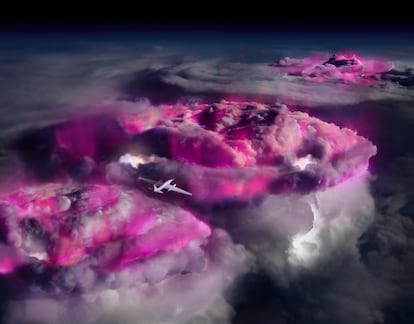Spy plane observes how storms produce radioactive clouds and antimatter
Two new studies shed light on the mystery of how lightning is triggered in thunderstorms

In 1960, the Soviet Union shot down the plane of U.S. pilot Francis Gary Powers as he flew over Yekaterinburg. The pilot was captured alive and sentenced to 10 years in prison, while the wreckage was put on public display. It was known as the U2 incident, named after the spy plane piloted by Powers — an aircraft designed at the CIA’s request to fly at high altitudes and photograph Communist arsenals without detection.
Six decades later, the same type of aircraft — now converted for scientific use — has enabled scientists to see what happens inside thunderstorms as never before. While thunderstorms can be studied from both Earth and space, the exact mechanisms that trigger lightning remain unknown. Lightning can heat the atmosphere to an astonishing 20,000 degrees Celsius, three times hotter than the surface of the Sun.
In July 2023, NASA carried out 10 flights with its ER-2 aircraft, the same model as the U2s used in the Cold War. The U.S. space agency aimed to conduct an unprecedented experiment: to ascend to an altitude of 12 miles and repeatedly fly over the most severe tropical storms in the Caribbean and Central America at that time. This jet — equipped with scientific instruments — can glide for hours. On the ground, a team of researchers, meteorologists, and military personnel guided the pilot, alerting them to the location of impending electrical discharges with the code word “glow!” The pilot navigate just 1.5 miles from the clouds and their electrical activity, bringing science closer to storms than ever before.

The results of the experiment revealed that storms produce radioactivity in the form of gamma rays, the same type of radiation generated by nuclear explosions and the decay of elements like uranium. While previous experiments had confirmed the existence of this phenomenon, the scale observed by NASA’s aircraft is unprecedented. These storms generate gamma rays for hours, covering areas of over 3,400 square miles — almost equivalent to the entire size of Europe.
In two studies published Wednesday in the prestigious journal Nature, scientists liken the phenomenon to a pot of boiling water, where each bubble represents a flash of gamma rays that lasts only fractions of a second, illuminating the sky with flashes of light invisible to the naked eye.
Due to its design, the ER-2 can only accommodate one pilot, who wears a pressurized suit similar to an astronaut’s. One pilot noted that the clouds appeared to have “a strange purple color because of the rapid rate at which the rays were discharged.” Steve Cummer, an electrical engineer at Duke University and co-author of the first study, explained, “For the first time, we know that this process is very common, with spectacular visual displays and gamma rays, which are invisible without specialized equipment, working in unison to release energy.”
Martino Marisaldi, a physicist at the University of Bergen in Norway and co-author of the second study, emphasized that storm clouds are the largest natural particle accelerators on Earth. “At any given time, there are about 2,000 active storm clouds on the planet, generating approximately 45 lightning strikes per second. This is one of the most powerful processes we can imagine, and understanding how it occurs is essential,” he stated.
The big mystery surrounding lightning is that it requires electric fields 10 times greater than those observed in storms so far, leaving scientists uncertain about how the electrical discharge is actually initiated.
These scientists have identified a new type of gamma ray within storms, termed a flickering gamma-ray flash (TGF). This phenomenon serves as the “missing link” between two previously known types of gamma rays: long-duration flashes, which can last over a minute, and terrestrial flashes, which are more intense but only last for microseconds. TGFs occur just after the longer flashes and before the occurrence of lightning, suggesting the existence of an unknown process that discharges energy in the form of gamma rays, potentially acting as a precursor to lightning formation.
“If this process did not occur, storms would be much more electrified and would likely produce more powerful and dangerous discharges,” Cummer acknowledges. The new findings align well with existing knowledge from a cosmological perspective: gamma rays are the most powerful form of radiation in the universe and can release more energy in fractions of a second than all the stars in the universe combined.
Another intriguing process occurring within storm clouds resembles something out of a science fiction movie: an avalanche of out-of-control relativistic electrons. These electrons are termed “relativistic” because they travel at nearly the speed of light, which is the maximum speed permissible in the universe according to Albert Einstein’s theory of relativity. When these electrons collide with air molecules, they generate high-energy electrons and photons. The potential within the cloud becomes so immense that positrons are also created — antimatter particles that are complementary to electrons but carry an opposite charge. “We now know that many storms emit gamma rays and produce antimatter,” says Cummer.
The team behind the study believes they are now closer to understanding exactly how lightning is generated. “For the first time, we see that gamma rays are not merely a scientific curiosity, but a fundamental process that likely occurs in all storms with sufficiently strong electric fields,” says Marisaldi. This includes not only tropical storms, but also storms that can occur in Europe. “This work lays the groundwork for further investigation into how the production of energetic particles leads to lightning, one of the greatest enigmas of atmospheric physics,” he adds.
Scientists believe that gamma ray flashes pose no risk to humans; one would need to be extremely close to receive a significant dose. However, getting too close to a storm does carry risks. The most dangerous aspect of flying a plane into such storms is the massive turbulence, which could potentially overturn the aircraft. While lightning strikes are a concern, they are not overly worrisome. It is relatively common for commercial airliners to experience electrical shocks — occurring about twice a year — and in most cases, there is no damage.
These two new studies contribute to an emerging field known as high-energy atmospheric physics, as explained by physicist and mathematician Joseph Dwyer of the University of New Hampshire in an independent commentary. “It is mind-boggling that two decades into the 21st century, the Earth’s atmosphere still holds enough surprises to inaugurate an entirely new field of science.” Research conducted with instruments like NASA’s old spy plane could lead to a revolution in our understanding of storm electrification and lightning, he adds.
Sign up for our weekly newsletter to get more English-language news coverage from EL PAÍS USA Edition
Tu suscripción se está usando en otro dispositivo
¿Quieres añadir otro usuario a tu suscripción?
Si continúas leyendo en este dispositivo, no se podrá leer en el otro.
FlechaTu suscripción se está usando en otro dispositivo y solo puedes acceder a EL PAÍS desde un dispositivo a la vez.
Si quieres compartir tu cuenta, cambia tu suscripción a la modalidad Premium, así podrás añadir otro usuario. Cada uno accederá con su propia cuenta de email, lo que os permitirá personalizar vuestra experiencia en EL PAÍS.
¿Tienes una suscripción de empresa? Accede aquí para contratar más cuentas.
En el caso de no saber quién está usando tu cuenta, te recomendamos cambiar tu contraseña aquí.
Si decides continuar compartiendo tu cuenta, este mensaje se mostrará en tu dispositivo y en el de la otra persona que está usando tu cuenta de forma indefinida, afectando a tu experiencia de lectura. Puedes consultar aquí los términos y condiciones de la suscripción digital.
More information
Archived In
Últimas noticias
The journal ‘Science’ criticizes Trump’s anti-renewable energy policy: ‘The US is failing to benefit from its own innovations’
Cubans hope for a miracle as dengue and chikungunya spread
The long shadow of the father figure in the films of Rob Reiner
US sanctions against jailed cartel leader ‘El Marro’ highlight Mexico’s lack of control over its prisons
Most viewed
- Christian Louboutin: ‘Young people don’t want to be like their parents. And if their parents wear sneakers, they’re going to look for something else’
- ‘El Limones’ and the growing union disguise of Mexican organized crime
- Cartels in Mexico take a leap forward with narco-drones: ‘It is criminal groups that are leading the innovation race’
- ‘We are dying’: Cuba sinks into a health crisis amid medicine shortages and misdiagnosis
- The low-cost creative revolution: How technology is making art accessible to everyone











































